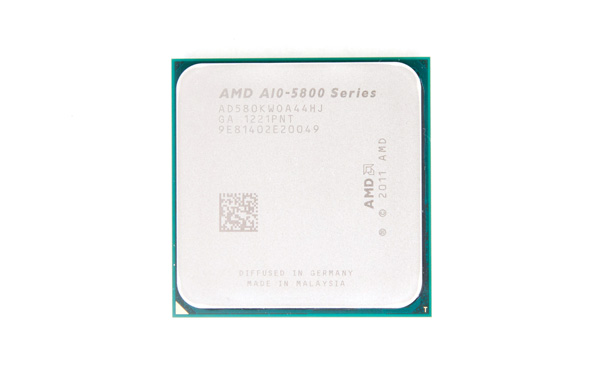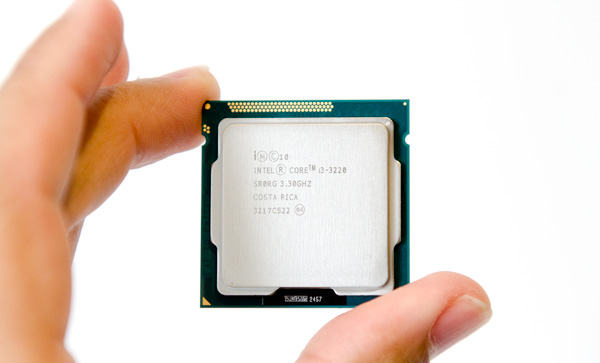AMD A10-5800K & A8-5600K Review: Trinity on the Desktop, Part 2
by Anand Lal Shimpi on October 2, 2012 1:45 AM ESTAlthough AMD's second-generation mainstream APU platform, codename Trinity, launched months ago in notebooks the official desktop launch is today. Rumor has it that AMD purposefully delayed the desktop Trinity launch to clear out unsold Llano inventories in the channel. Although selling APUs in notebooks is pretty easy, convincing desktop users to forgo the discrete GPU option (and ignore Intel) has been a tough battle for AMD. I keep going back to two slides that show us where AMD wants to go and the cores it'll take to get there:

The ultimate goal is this beautiful cohesive operation between CPU and GPU on a single die. That future will require a lot of software support, not only at the application level but also at the OS level. And I'm not talking about Windows 8. We're still far away from this APU dominated future, but AMD is marching in that direction. The second slide shows the x86 cores that we'll see from AMD along the way. AMD is still playing catch-up in the x86 CPU space and it's got a lot of lost time to make up for. There's no hiding the fact this is going to be a multi-year effort to simply get close to Intel's single-threaded x86 performance. Through pricing, leveraging its GPU technology and throwing more transistors at the problem AMD can still deliver competitive solutions, but it's not going to be a walk in the park.
Last week we took a look at the GPU side of the desktop Trinity APUs. We looked at the top end 384-core Radeon HD 7660D configuration as well as the slightly slower 256-core Radeon HD 7560D GPU, both of which easily outperformed Intel's HD 4000 and HD 2500. As far as processor graphics go, Trinity on the desktop maintains a healthy lead over Intel. There's still a place for discrete GPUs but that's pretty much at the $100 and above price points.
Today we're able to talk about pricing and x86 CPU performance among other things. The good news on that front is the most expensive Trinity APU is fully unlocked and is priced at $122:
| AMD Socket-FM2 Lineup | ||||||||
| Modules/Cores | CPU Clock Base/Turbo | L2 Cache | GPU | TDP | Price | |||
| A10-5800K | 2 / 4 | 3.8 / 4.2 GHz | 4MB | 384 cores @ 800MHz | 100W | $122 | ||
| A10-5700 | 2 / 4 | 3.4 / 4.0 GHz | 4MB | 384 cores @ 760MHz | 65W | $122 | ||
| A8-5600K | 2 / 4 | 3.6 / 3.9 GHz | 4MB | 256 cores @ 760MHz | 100W | $101 | ||
| A8-5500 | 2 / 4 | 3.2 / 3.7 GHz | 4MB | 256 cores @ 760MHz | 65W | $101 | ||
| A6-5400K | 1 / 2 | 3.6 / 3.8 GHz | 1MB | 192 cores @ 760MHz | 65W | $67 | ||
| A4-5300 | 1 / 2 | 3.4 / 3.6 GHz | 1MB | 128 cores @ 724MHz | 65W | $53 | ||
| Athlon X4 750K | 2 / 4 | 3.4 / 4.0 GHz | 4MB | N/A | 100W | $81 | ||
| Athlon X4 740 | 2 / 4 | 3.2 / 3.7 GHz | 4MB | N/A | 65W | $71 | ||
Compare this to Llano's launch where the top end SKU launched at $135 and you'll see that AMD is somewhat getting with the times. I would still like to see something closer to $100 for the A10-5800K, but I find that I'm usually asking for a better deal than what most CPU makers are willing to give me.
AMD's competitive target is Intel's newly released Ivy Bridge Core i3 processors. There are only five Core i3s on the market today, four of which use Intel's HD 2500 graphics. The cheapest of the lineup is the Core i3 3220 with two cores running at 3.3GHz for $125. Intel disables turbo and other features (there's effectively no overclocking on these parts), which AMD is attempting to exploit by pitting its Trinity K-series SKUs (fully unlocked) against them. AMD's TDPs are noticeably higher (100W for the higher end K-series parts compared to 55W for the Core i3s). Intel will easily maintain the power advantage as a result under both CPU and GPU load, although AMD's GPU does deliver more performance per watt. Power consumption is a major concern of AMD's at this point. Without a new process node to move to for a while, AMD is hoping to rely on some design tricks to improve things in the future.
At the low end of the stack there are also two Athlon X4s without any active GPU if you just want a traditional Trinity CPU.
The Test
This will be our last CPU/APU review on the current test platform/software configuration. The next major CPU review will see a move to a brand new testbed running Windows 8. As always you can get access to far more numbers than what we report here if you use our performance comparison engine: Bench. Of course if you want to see the GPU and GPU Compute performance of AMD's Trinity APU check out part one of our coverage.
| Motherboard: |
ASUS P8Z68-V Pro (Intel Z68) ASUS Crosshair V Formula (AMD 990FX) Gigabyte GA-F2A85X-UP4 (AMD A85X) Intel DZ77GA-70K (Intel Z77) |
| Hard Disk: |
Intel X25-M SSD (80GB) Crucial RealSSD C300 OCZ Agility 3 (240GB) |
| Memory: | 2 x 4GB G.Skill Ripjaws X DDR3-1600 9-9-9-20 |
| Video Card: |
ATI Radeon HD 5870 (Windows 7) AMD Processor Graphics Intel Processor Graphics |
| Video Drivers: | AMD Catalyst 12.8 |
| Desktop Resolution: | 1920 x 1200 |
| OS: | Windows 7 x64 |













178 Comments
View All Comments
mattgmann - Tuesday, October 2, 2012 - link
I still don't understand where these CPUs fit in the market. Sure, this line of CPUs has made some advances, but the features it relies on to succeed aren't good enough in real world applications.1. Gaming. It's still not fast enough to run modern games. Not to argue, but lowest possible settings and super low frame rates aren't good enough.
2. Content creation. In certain points in your day you may run a short program that's optimized to work well. But the rest of the day, you'll be wishing you had a quad core intel.
3. Casual home/office use. A pure waste of electricity. The intel chip decodes HD video fine and provides a quicker user experience with a much lower energy cost (and is dead silent)
The "upgrade path" argument doesn't make a ton of sense either. In reality, not many people actually follow upgrade paths on platforms, because, in reality, you end up spending today's prices for yesterdays technology. Low end systems just aren't meant to be upgraded; they're meant to be replaced.
I REALLY want AMD to give intel a kick in the but. I miss the days of low end, unlocked intel processors. Think of what those little i3's could probably do with unlocked multi's, 1.4V vcore and some fast memory!
At least this is a step in the right direction for amd....sort of
Hubb1e - Tuesday, October 2, 2012 - link
I'm sorry but your answers to your own question are inaccurate.1. Gaming. For many people who are not on this forum low / medium settings are fine and older games are cheaper to buy and are still fun. Wow and Diablo play very nicely on this APU at medium / high settings and that is where the vast majority of casual gamers are buying.
2. Content creation. If you are wishing you had a quad core intel then you're in need of a real workstation, not an i3 competitor. I work fine on a mobile i5 -540 at 2.5ghz. 90% of the time it is idle.
3. Casual home office use is all idle and if you go back and look Trinity idles lower than Ivy so I don't see your point about it being a waste of electricity. A quicker user experience is about the SSD and not the CPU. Users will not notice a 12% difference in CPU performance.
4. Agree with the upgrade path, though as a builder for my family FM1 being a dead end made it a socket that I didn't want to touch.
mikato - Wednesday, October 3, 2012 - link
Well said. I would also like to point out that Angry Birds and Words With Friends are also "modern games".vegemeister - Wednesday, October 3, 2012 - link
1. Gaming: Look at those benchmarks. Low settings, punk-ass resolution, no AA, and STILL DROPPING FRAMES.HTPC: there are two kinds pf CPUs for HTPC: those that can decode 10 bit h.264 at 1920x1080 in real time, and those that cannot. Unfortunately, this review doesn't have benchmarks for that.
iTzSnypah - Tuesday, October 2, 2012 - link
The A4-5300 looks promising for its price and intended use. I keep telling my brother that he really needs to upgrade his computer (8 year old HP with Single-core AMD Athlon X64) and the A4-5300 looks like it would fit his needs perfectly. I get tired of going to his house and waiting 5 minutes to open the internet. Also only being able to watch 360/480p (depending on the 'mood' of the computer) is beyond annoying. Its his birthday this month so I might surprise him.Hubb1e - Tuesday, October 2, 2012 - link
I have a single core Athlon64 at 2.4 ghz that works just fine. The problem is a lack of ram, slow hard drive, OS bloat, and a lack of GPU acceleration for youtube. I have 1.5GB of memory and a good video card that offloads youtube and the single core computer runs pretty well. I am constantly amazed at how well it works for casual use.But yeah, an upgrade could be in order but I'd argue the Celeron G530 would be a better choice. Anand tests the Pentium and it actually beats the A10 in some benches. The G530 is still a full dual core CPU and is only a few mhz slower. The A4 drops a whole module and in benches on Toms looks pretty slow.
Jamahl - Tuesday, October 2, 2012 - link
Where was the A4 benched on Tom's? From what I can tell the A6-5400K is drawing very close to the 3870K in gaming. The A4 will be further behind but it'll still be up with say, the triple core A6-3500 performance imo.Ananke - Tuesday, October 2, 2012 - link
These are great for OEM, the 95% of the PC market :). You know, what people are buying from HP, Dell, Lenovo etc.Enthusiasts will probably not be appealed by Trinity, but enthusiasts are very small market.
wenbo - Tuesday, October 2, 2012 - link
Enthusiasts are very small market, but they are very VERBAL :)vegemeister - Tuesday, October 2, 2012 - link
I see that you are planning to move to a newer version of x264 for benchmarking. Since direct comparisons are going to be invalidated anyway, why not go ahead and move to a crf encode like everyone else not stuck in the last decade?2-pass does not compress any more effectively than 1-pass. The only reason to use it is to get very close to a particular file size. x264 is much better than you at deciding how many bits it needs for acceptable quality on a particular file. These days, most people store their video on media far larger than a single file. It no longer makes sense to benchmark the use case of sqeezing as much quality as possible out of 700 MB.